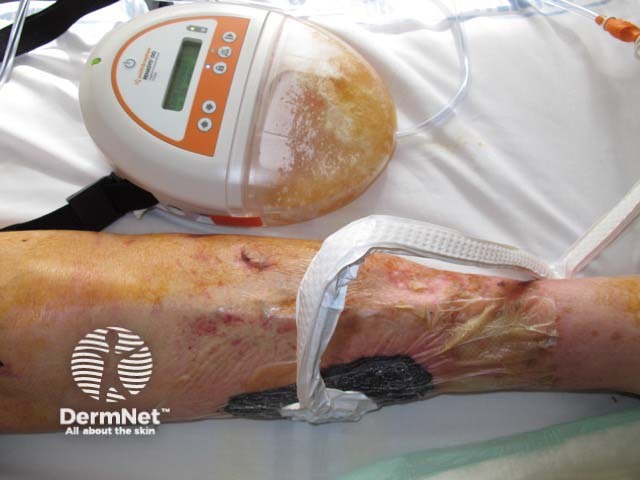Main menu
Common skin conditions

NEWS
Join DermNet PRO
Read more
Quick links
Author: Anoma Ranaweera, Medical Writer, Auckland, New Zealand, 2013.
Introduction How does it work? Devices and placement When is it appropriate? Contraindications Clinical effectiveness Costs
Negative pressure wound therapy refers to wound dressing systems that continuously or intermittently apply subatmospheric pressure to the surface of a wound to assist healing. Negative-pressure wound therapy is also called vacuum-assisted wound closure therapy, It has become a popular treatment modality for the management of many acute and chronic wounds.
The best pressure for wound healing appears to be approximately 125 mm Hg, using an alternating pressure cycle of 5 minutes of suction followed by 2 minutes off suction.
Animal studies have demonstrated that this technique:
Additionally, intermittent low pressure alters the structure of the cells in the wound bed, triggering a cascade of intracellular signals that increase the rate of cell division and the formation of granulation tissue.
There are now several commercially available systems for negative-pressure wound therapy and multiple dressing options engineered for specific wound applications.
Mains-operated systems are available for patients with limited mobility or heavily exuding wounds. Lightweight, battery-powered units have a smaller canister volume suitable for an ambulatory patient with a wound that has minimal to moderate levels of exudate. Units can be programmed to provide varying degrees of pressure either continuously or intermittently.
During the procedure:
Negative-pressure wound therapy dressings should be changed every 48 hours. If there is infection the dressing should be changed every 24 hours. It may be possible to leave the dressing on for longer periods if the wound is not infected. Depending on the type of wound, negative pressure wound therapy may be needed for 2–6 weeks.
The main reasons for using a mains-powered negative-pressure wound therapy unit are:
A battery-powered ambulant negative-pressure unit is recommended for:

Negative-pressure wound therapy

Wound undergoing treatment with negative-pressure device
Negative-pressure wound therapy is unsuitable for some wounds.
Silver-containing dressings should not be used if the patient is sensitive to these.
Compared with conventional wound therapy, the proposed advantages of negative-pressure wound therapy are:
The effectiveness of negative-pressure wound therapy is less certain in patients with:
If this method is successful, benefits may include:
The disadvantages of this form of wound treatment include:
Negative-pressure wound therapy is not always effective and a non-healing wound may require other potentially more invasive treatment.
Rarely, complications may occur which may require discontinuation of negative-pressure wound therapy. These may include:
Negative-pressure wound therapy may need to be stopped if the patient experiences:
The cost of treating wounds with negative-pressure wound therapy is similar to conventional wound treatment but it may have economic advantages or disadvantages in individual cases.